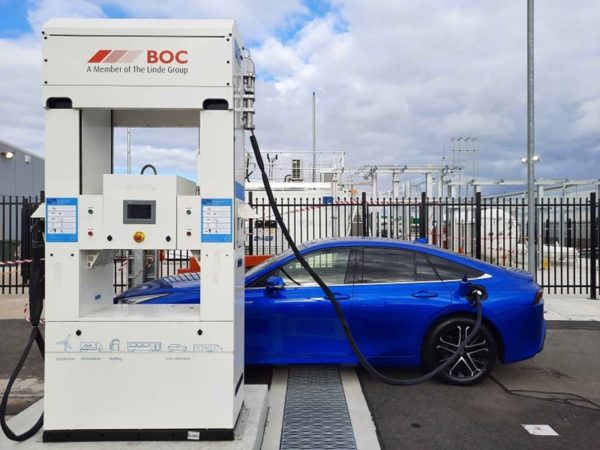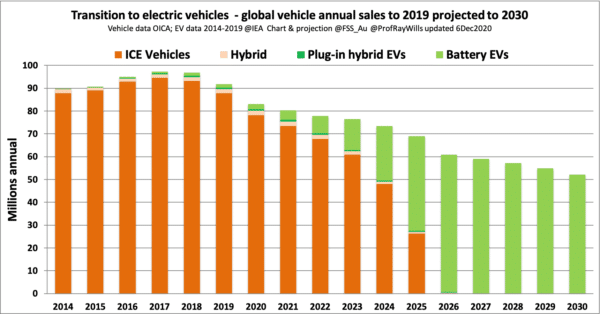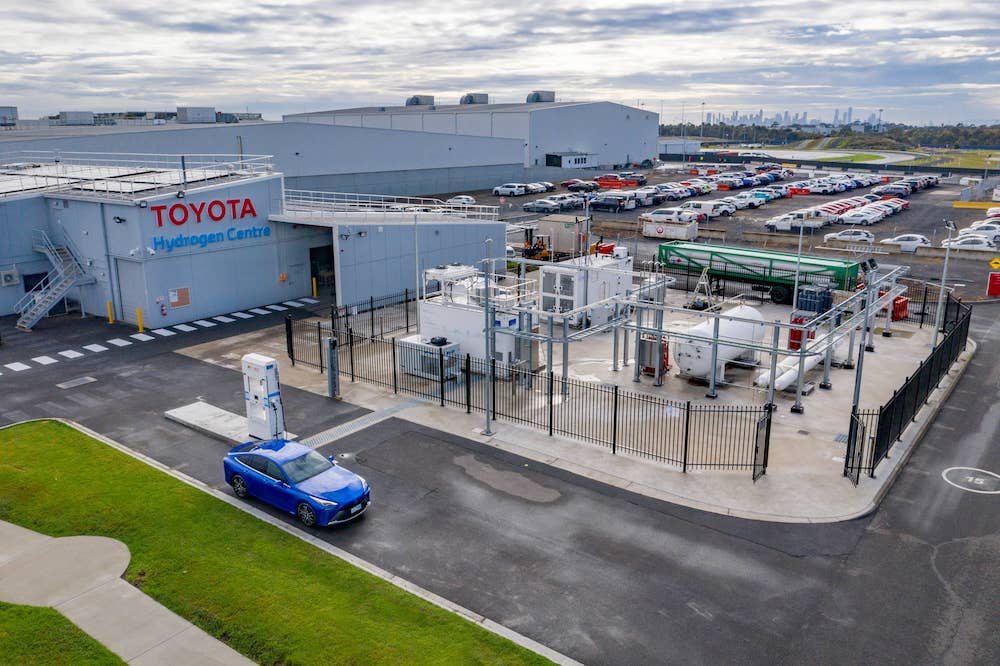The transformation of Toyota’s decommissioned car manufacturing plant in Altona, Victoria into a renewable energy hub producing green hydrogen for transport is complete. On Monday, the carmaker unveiled its $7.4 million Hydrogen Centre, which includes Victoria’s first commercial-grade permanent hydrogen production, storage and refuelling facility as well as education centre.
The hydrogen production facility is powered by an 87 kW solar array along with 100 kW of battery storage. It will produce up to 80kg of hydrogen on site everyday with its 200 kW electrolyser. The hydrogen will then be stored in a bank of storage tubes at medium and high pressure to be able to refuel commercial and passenger hydrogen fuel cell electric vehicles (HFCEVs), like Toyota’s Mirai FCEV. The station is capable of filling a Toyota Mirai in approximately 3 minutes, giving the vehicle a range of 650km.
While Toyota’s Mirai model is not on general sale in Australia, it has been sold in Japan and US for the past seven years. Toyota noted the lack of refuelling infrastructure as one of the main hurdles to bringing FCEVs to the Australian market, saying the new centre is an important step in addressing the challenge.
To get its Mirai HFCEV on Australians roads, the company has partnered with Victorian businesses to lease fleets of the hydrogen-powered vehicles. According to partner BOC’s statement, Toyota is also organising a HFCEV fleet trial in Western Australia.
In addition to the passenger cars, Toyota also uses fuel-cell forklifts in parts of the Altona complex, which will be powered by the hydrogen produced on site.

BOC
Last week, Neoen and ActewAGL opened Australia’s first hydrogen vehicle refuelling station in Canberra, catering to the state government’s new fleet of Hyundai Nexo hydrogen cars.
Toyota’s hydrogen refuelling station at its former car manufacturing site, which closed in 2017, was installed by gas and engineering company BOC, a subsidiary of Linde plc, which has installed 180 hydrogen refuelling stations worldwide, refuelling around 1.5 million cars.
Future of HFCEVs
While hydrogen seems to be 2021’s hottest buzzword, questions about its role for passenger vehicles remain. Professor Ray Wills, Managing Director and owner of Future Smart Strategies, says it’s “unlikely” hydrogen will manage to overtake batteries as the preferred transport fuel.
With the massive amounts of energy, attention and, most importantly, funding being poured into hydrogen – especially in Australia – many remain hopeful about the fuel’s potential markets.

Professor Ray Wills
Demonstration-focused station
Given hydrogen as a transport fuel is only just finding its feet in Australia, Toyota’s Hydrogen Centre, which was developed with $3.1 million of funding support from the Australian Renewable Energy Agency (ARENA), is focussed on demonstrating possibilities as much as it is about refuelling actual cars.
Toyota Australia’s President and CEO Matthew Callachor said the Toyota Hydrogen Centre was built to showcase the benefits of hydrogen fuel cell technology.
“By demonstrating the viability of renewably-produced hydrogen as an automotive and energy fuel through this project, Toyota and its partners in government and business are pioneering a cleaner, more sustainable future that will encourage the further acceptance of this technology.”
“The infrastructure which is being commissioned at this new Toyota facility will not only progress the deployment of hydrogen vehicles, which can make a major contribution to helping our transport sector navigate Australia’s energy transition, but it will also serve as a beacon to other companies looking to invest in hydrogen transport technology,” Dr Patrick Hartley, from the CSIRO Hydrogen Industry Mission, said at the Centre’s opening.
Solar-powered facilities
Toyota has committed to achieving zero CO2 emissions from its vehicles and plants under the Toyota Environmental Challenge 2050. To reach its target, the company has invested heavily in installing solar arrays in key properties in Sydney, Altona, and Brisbane.
The largest system is installed on the Toyota Parts Centre in Western Sydney, featuring a 605kW solar array made up of 2,200 panels.
This content is protected by copyright and may not be reused. If you want to cooperate with us and would like to reuse some of our content, please contact: editors@pv-magazine.com.









1 comment
By submitting this form you agree to pv magazine using your data for the purposes of publishing your comment.
Your personal data will only be disclosed or otherwise transmitted to third parties for the purposes of spam filtering or if this is necessary for technical maintenance of the website. Any other transfer to third parties will not take place unless this is justified on the basis of applicable data protection regulations or if pv magazine is legally obliged to do so.
You may revoke this consent at any time with effect for the future, in which case your personal data will be deleted immediately. Otherwise, your data will be deleted if pv magazine has processed your request or the purpose of data storage is fulfilled.
Further information on data privacy can be found in our Data Protection Policy.